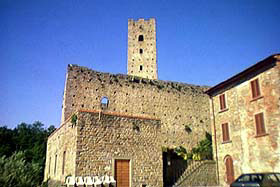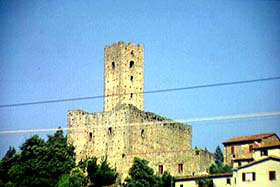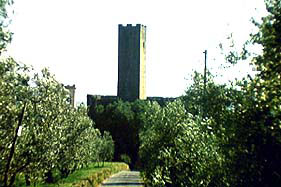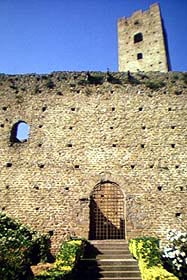Larciano Castle
The castle of Larciano can be reached following the speedway FI-PI-LI up to
the exit 'S.Miniato' continuing then toward Fucecchio and from here toward Pistoia/Cerreto
Guidi. Reached S.Rocco of Larciano, the modern installation, a poster will point
out the road that will conduct to the castle, around three kilometers far.
 |
Larciano dominates the western slopes of the Albano mountain. The zone was
a center of human habitation since the Roman age, as testified by numerous archaeological
recoveries, and the same name of the castle is derived from 'Larcius', a Latin
personal name. During the whole Middle Ages Larciano was the principal center
of the area, first of all thanks to the link of the Road Francigena that from
here went up the Albano mountain toward Serravalle.
Certain sources name the castle as a possession of the counts of the Guidi family
from the first half of the 10th century and subsequently this dominion was confirmed
on the noble family from the emperors Arrigo VI and Federico II. In the year
1225 the castle was sold to the Commune of Pistoia and for its dominant position
it became the fulcrum of the Pistoiesi defenses on this slope of the Albano
mountain. In this period the castle and the walls of the country were strengthened..
In the year 1302 Larciano fell to a siege by Florentine troops, allied with
those Lucchesi. To recover it Pistoia had to pay, in 1310, 10.000 gold florins.
When, in 1391, a common danger - the possible descent on Tuscany by Gian Galeazzo
Visconti - united Florentines and Pistoiesi, the castle became a base for the
two armies. Few years after, in 1401, Pistoia was subdued by Florence and Larciano
became the center of one of the Podesteries (territories administrate by a 'Podesta',
italian medieval term for chief magistrate or governor) who divided this territory.
In the time of its greatest glory the castle was surrounded by a strengthened
walled enclosure endowed with two gates, one called 'di Bagno' and the other
'S.Marco'. Crowning a rocky spur, the mighty fortress's battlements bristled
from its high tower making it possible to dominate the whole Valdinievole. The
complex was endowed with machicoulis and the town walls alternated from towers,
that today are lost. The fortress is inserted on the perimeter of the city enclosure
with a mighty curtain that closed the western angle of the same. Inside was
the palace of the podestà (governor or high magistrate) but today all the inner
dividing walls are gone, and only the beautiful windows which are now part of
the external walls remain. At the center of the courtyard was the ancient cistern
for the water. The whole complex is in good condition thanks to a recent restoration,
but this cannot be said for the city walls, now partly lost. However, preserved
intact are the two medieval gates. Inside the castle is found a small archaeological
museum, visible for a fee.
|



